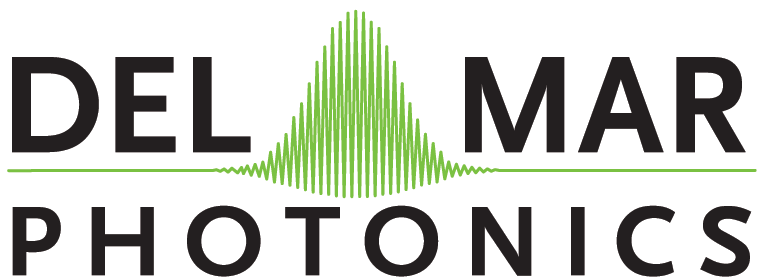
Del Mar Photonics, Inc.
4119 Twilight Ridge
San Diego, CA 92130
tel: (858) 876-3133
fax: (858) 630-2376
Skype: delmarphotonics
sales@dmphotonics.com
Multiphoton Microscope Alignment using Second Harmonics Generation Crystal
From: delmarphotonics
| March 03, 2010
Multiphoton Microscope Alignment using Second Harmonics Generation Crystal
Mavericks femtosecond Cr:Forsterite laser is aligned into Olympus FluoView
FV1000 using Second Harmonic Generation (SHG) crystal, in this case BBO
crystal, placed in the focal plane of the microscope.
The Mavericks-65 Cr:forsterite laser is tunable over wavelengths from 1230 to
1270 nm, making it ideal for imaging, condensed matter and biomedical
applications. These wavelengths are less damaging to biological samples than the
shorter wavelengths
produced by Ti:sapphire and other femtosecond lasers. This allows in vivo
imaging of cells and other biological
samples.
The MFM uses pulsed long-wavelength light to excite fluorophores within the
specimen being observed. The fluorophore absorbs the energy from two
long-wavelength photons which must arrive simultaneously in order to excite an
electron into a higher energy state, from which it can decay, emitting a
fluorescence signal. It differs from traditional fluorescence microscopy in
which the excitation wavelength is shorter than the emission wavelength, as the
summed energies of two long-wavelength exciting photons will produce an emission
wavelength shorter than the excitation wavelength.
Multiphoton fluorescence microscopy has similarities to confocal laser scanning
microscopy. Both use focused laser beams scanned in a raster pattern to generate
images, and both have an optical sectioning effect. Unlike confocal microscopes,
multiphoton microscopes do not contain pinhole apertures, which give confocal
microscopes their optical sectioning quality. The optical sectioning produced by
multiphoton microscopes is a result of the point spread function formed where
the pulsed laser beams coincide. The multiphoton point spread function is
typically dumbbell-shaped (longer in the x-y plane), compared to the upright
rugby-ball shaped point spread function of confocal microscopes.
The longer wavelength, low energy (typically infra-red) excitation lasers of
multiphoton microscopes are well-suited to use in imaging live cells as they
cause less damage than short-wavelength lasers, so cells may be observed for
longer periods with fewer toxic effects. Many researchers are currently working
toward better and higher resolution multiphoton imaging developments.
There was a recent discussion on that topic in Confocal Microscopy List with several very good example how it can be done.
I dissolved some KDP or KTP in hot water and let it evaporate onto slides and
coverslips. The resulting crystals give spectacular SHG performance:
http://www.ucalgary.ca/styslab/image
Scroll down and click on 'Second Harmonic Generation Imaging' to see my results!
The pictures were generated by imaging using a 60x or 40x oil lens through a
standard coverslip with crystals grown on the backside using the evaporating
method. Also, there are some pictures of rat tail collagen and dorsal column
membrane with SHG signal.
KDP and KTP are Potassium di- and tri-phosphate respectively. It usually
comes in a powder. You can image the powder directly, but the grains are small.
I prefer to dissolve the grains in hot water and grow larger crystals to get
better pictures. Let the water evaporate on a coverslip, or wait for a
supersaturated solution to cool; large crystals will precipitate out into
solution.
Craig
==============
Haven't tried it myself, but I've been told on good authority that a slice of
potato (lots of starch) will demonstrate SHG. You can hardly get cheaper than
that. I wonder if it still "performs" after it turns black from exposure to
air.
Carl Boswell
==============
A MP/SHG contact at Leica recommended urea crystals for SHG signal for
measuring the instrument response function of our FLIM component. I don't know
if you can buy this at the store (maybe online at amazon.com?), but you could
produce it yourself.
Slides containing what Guy Cox suggested can probably be purchased from Carolina
Biological Supply (www.carolina.com)
or Amazon.
George McNamara
================
There are biology shops which sell prepared slides for schools – skin would
be a good choice, as would tooth or bone. If you don’t care what you are looking
at and just want to see if you are detecting a signal, anything containing
starch will give a good signal. Flour, cornstarch, laundry starch – they should
all work. If you have any access to simple chemicals, either of the sodium
phosphates should be good and very bright indeed.
Guy Cox
Del Mar Photonics Product brochures - Femtosecond products data sheets (zip file, 4.34 Mbytes) - Del Mar Photonics
Send us a request for standard or custom ultrafast (femtosecond) product
Pulse
strecher/compressor
Avoca SPIDER system
Buccaneer femtosecond
fiber lasers with SHG Second Harmonic Generator
Cannon Ultra-Broadband Light
Source
Cortes Cr:Forsterite
Regenerative Amplifier
Infrared
cross-correlator CCIR-800
Cross-correlator Rincon
Femtosecond Autocorrelator
IRA-3-10
Kirra Faraday Optical Isolators
Mavericks femtosecond
Cr:Forsterite laser
OAFP optical attenuator
Pearls femtosecond fiber laser
(Er-doped fiber, 1530-1565 nm)
Pismo pulse picker
Reef-M femtosecond scanning
autocorrelator for microscopy
Reef-RTD scanning
autocorrelator
Reef-SS single shot
autocorrelator
Femtosecond Second Harmonic Generator
Spectrometer ASP-100M
Spectrometer ASP-150C
Spectrometer ASP-IR
Tamarack and Buccaneer
femtosecond fiber lasers (Er-doped fiber, 1560+/- 10nm)
Teahupoo femtosecond Ti:Sapphire regenerative amplifier
Femtosecond
third harmonic generator
Tourmaline femtosecond fiber
laser (1054 nm)
Tourmaline TETA Yb
femtosecond amplified laser system
Tourmaline Yb-SS
femtosecond solid state laser system
Trestles CW Ti:Sapphire
laser
Trestles femtosecond
Ti:Sapphire laser
Trestles Finesse
femtosecond lasers system integrated with DPSS pump laser
Wedge Ti:Sapphire multipass amplifier
References:
Two Photon Microscopy and Second Harmonic
Generation
Leif Gibb and David Matthews
SHG imaging: From molecules to tissues
Second-harmonic imaging microscopy of living cells
Second Harmonic Generation (SHG) Microscopy: The Forward-to-Backward (F/B) issue. Dr. Rebecca Williams
SECOND-HARMONIC GENERATION IMAGING OF COLLAGEN-BASED SYSTEMS
Interferometric Second Harmonic Generation microscopy
Second Harmonic Imaging of Plant Polysaccharides
Epi-third and second harmonic generation microscopic imaging of abnormal enamel
Membrane imaging by simultaneous second-harmonic generation and two-photon microscopy
 Del Mar Photonics, Inc.
|